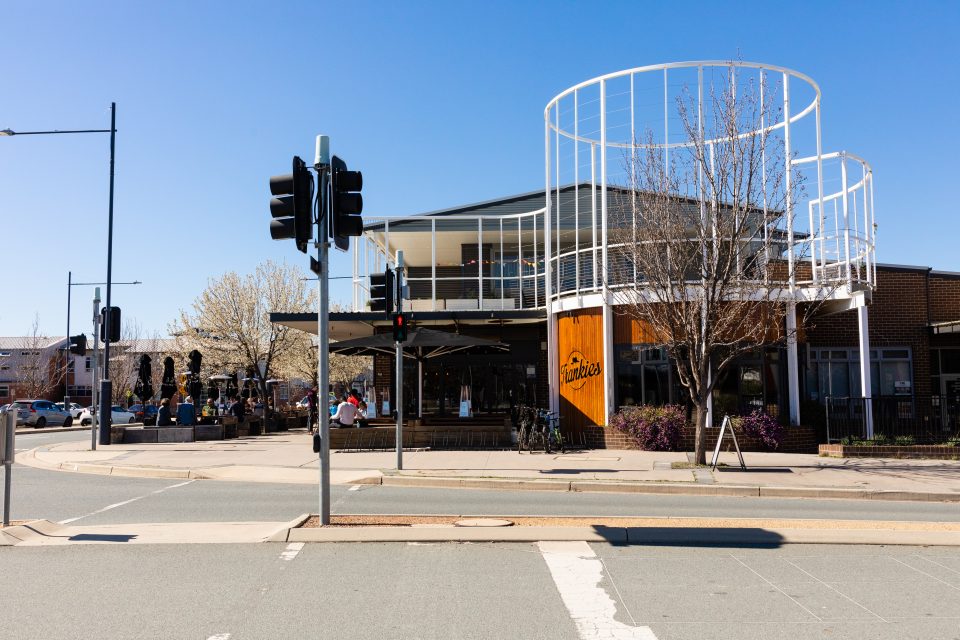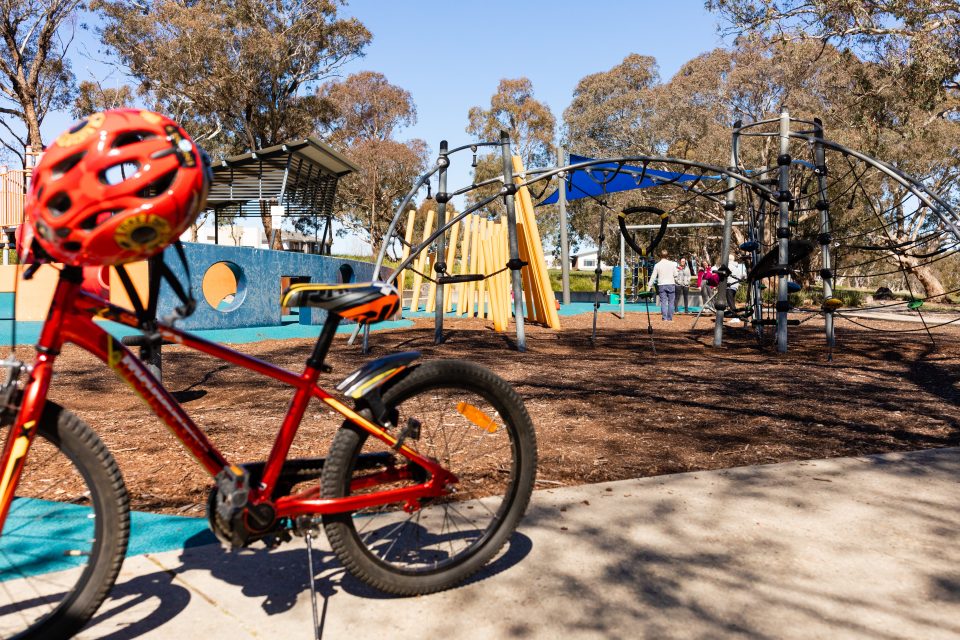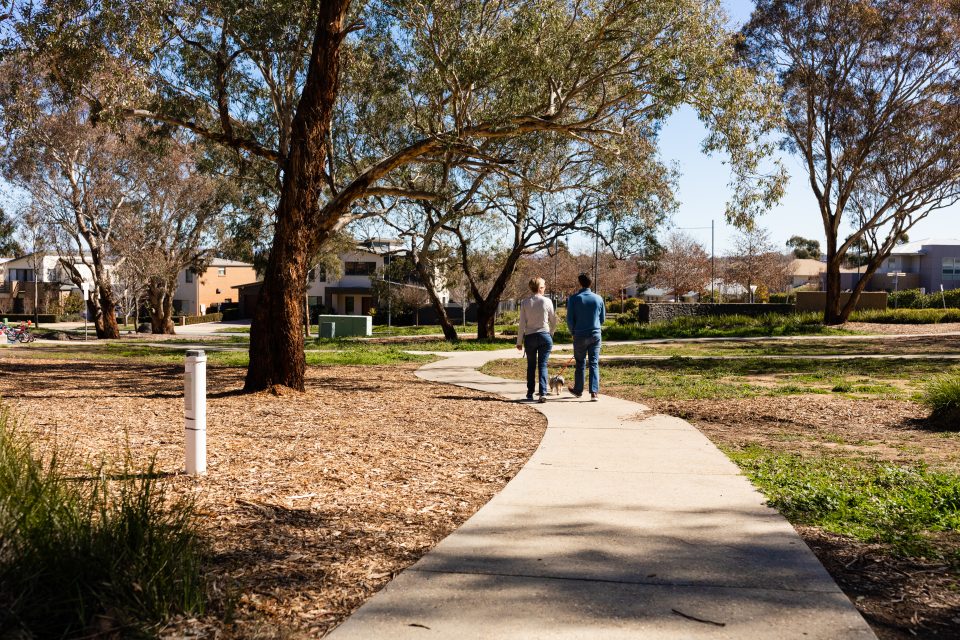
Local resident Tamil loves to take his sone Agaran to Aqua Tots in Forde for lessons on the weekend. He says the staff are super friends and make the kids feel comfortable. Photo: Daniella Jukic.
If you think living in Gungahlin isn’t for you, Forde might just be the suburb that changes your mind. With more than half the suburb surrounded by parkland, wetlands or nature reserves, Forde is a far cry from what many Canberrans assume living in a newer suburb development is like.
The suburb, which is tucked away in the ACT’s most northern pocket, abuts native wildlife haven Mulligans Flat Reserve. But it’s also just a five-minute drive to Gungahlin Town Centre, schools and shopping centres.
Thinking about visiting or moving to Forde? Here’s what you need to know.

Forde has a lovely friendly vibe, perfect for families. Photo: Daniella Jukic.
History
Forde is named after Frank Forde, who served as an Australian Prime Minister for just one week in 1945. Settlement of the suburb began in 2008.
Parts of North Forde are culturally significant to the local Aboriginal people, including the waterway near Foy Street, which is in the same location that a tributary of Ginninderra Creek once flowed. According to the ACT Government, “Aboriginal people were attracted to the site and its resources because of its proximity to water and its north-westerly aspect. This is evident in the high concentration of artefacts.”

Did you know Forde is named after Frank Forde, who served as Prime Minister for one week? Photo: Daniella Jukic.
Shops and eateries
Forde’s local shopping centre has retailers including a supermarket, pharmacy and hairdresser. But, perhaps surprisingly given its status as a suburban shopping centre near the outskirts of Canberra, it’s best known for its food.
Frankies at Forde is a cafe by day, and licensed bar and restaurant at night. It was also one of the first Canberra cafes to ban takeaway coffee cups, with customers bringing their own reusable coffee cups (or buying a keep cup in-store) instead.






Nearby, Da Bronx serves up authentic New York pizza, with a menu of jumbo 18-inch pizzas named after iconic New York locations. And Cantonese restaurant Jimmy’s Palace does a solid trade of affordable classic dishes like sweet and sour pork and cashew chicken.
Places of interest and things to do

Heritage Park on Francis Forde Blvd, Forde. Photo: Daniella Jukic.
There aren’t many suburbs where you can have a native animal encounter without going far from your home, but in Forde it’s easy. Mulligans Flat Woodland Sanctuary is on the border of Forde and Bonner. In 2009, introduced predators were removed and Eastern bettongs, bush-stone curlews and quolls were introduced.
The sanctuary is the only place where you can see Eastern bettongs on mainland Australia in the wild, plus there are wallabies, kangaroos and abundant birdlife to look out for.
Playgrounds and parks





Popular playgrounds and parks in Forde include:
- Heritage Park and Pathway. In Ray Ellis Crescent, you’ll find a shady playground, barbecue facilities and picnic spots, as well as a walk which has signs explaining the history of the area’s early settlers. You can also discover the remains of huts, fences, sheep shearing sheds and an old school as you wander along the nearby Heritage Pathway.
- Forde Hill Playground (access via Quinane Avenue). According to Google reviews, this playground is a great spot for catching pokemon. But if that’s not your thing, the shaded playground also has modern climbing equipment, a swingset and picnic facilities.
- Linear Park (access via Turbayne Crescent, Volpato Street and Foy Street). With a waterway, small playground, barbecue facilities and bike paths, Linear Park has something for the whole family to enjoy.
Getting around
Transport Canberra bus routes 19 and 20 service Forde. The nearest light rail stop is Gungahlin Place, which is five minutes away by car.
Prefer driving? Horse Park Drive runs alongside Forde, so it’s easy to get to Gungahlin and other parts of Canberra. It’s about 25 minutes by car from Forde to Civic and Belconnen, and 30 minutes to Woden and Tuggeranong.
Schools

Neville Bonner Primary School in Bonner is nearby. Photo: Region Media.
In addition to Burgmann Anglican School’s Forde campus (for students in preschool to Year 2 and Years 6 to 8), Forde parents are spoiled for choice when it comes to schools in neighbouring suburbs.
Nearby schools include Neville Bonner Primary School, Amaroo School (kindergarten to Year 10), Harrison School (preschool to Year 10) and Gungahlin College (Years 11 and 12).
Why the locals love it

Frankies at Forde is popular amongst the locals, serving coffees by day and is fully licensed bar/restaurant by night. Photo: Daniella Jukic.
There are plenty of reasons locals love Forde. Most houses are directly opposite nature reserves or parkland, so there’s more to look at than rows upon rows of identical houses. The local amenities area plentiful, there’s a relatively low crime rate, and of course, you can’t forget the annual and spectacular Christmas lights display on Huddy Street.
Quick facts
- Median age: 33 years
- Median weekly household income: $2,944
- Median weekly rent: $510
- Houses vs. apartments: 80.8% houses; 1.4% apartments
- Suburb sales record (excludes land sales): $2,035,000 in 2018
Source: 2016 Census.
Want to find the latest real estate listings for sale and rent in Forde? Zango can help you find them:
Do you live, or have you previously lived, in Forde? What are your favourite things about the suburb? What advice would you give to people considering moving there? Share your thoughts in the comments below.


























